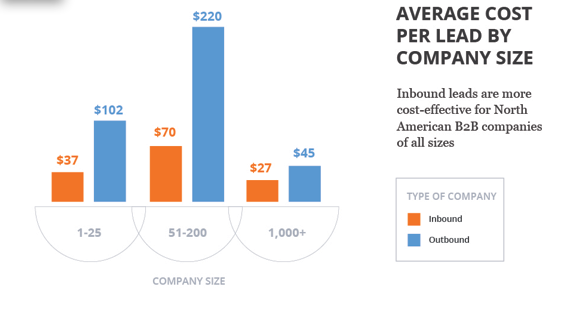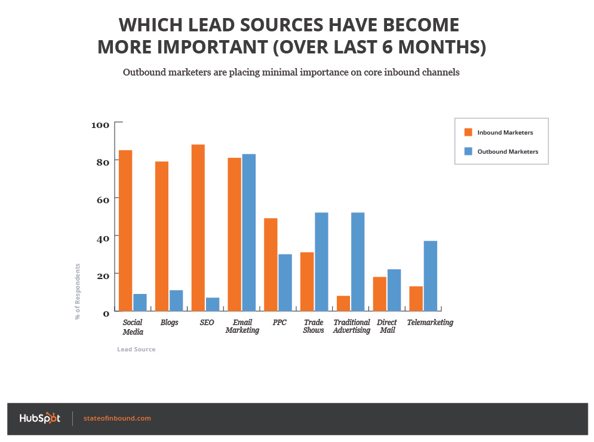Curious how to recruit the right students at the right acquisition cost?
I bet that chart above got your attention. While that was 2012, the numbers have gotten even more compelling in 2014:
You might say that those were for B2B companies. Perhaps. But the trend is very powerful for B2B and B2C.
Overall, to source leads/prospects/students the tools have become the core of inbound marketing methods — social media, blogs, SEO and email marketing.
How does this all apply to Higher Education?
In you work in higher education, you are always trying to get the attention of your current students, potential students, alumni, and parents. Inbound marketing is one way to move your audience into action. Think of this as publishing the right content to the right market at the right time.
Your market is online ALWAYS. They are asking questions, some of which are less about your college then about how to answer a question they have about colleges. You are a successful college and you have a great deal of content to share. There are lots of great stories to tell about your students, the alumni and the faculty – and those great sports teams.
However, as we reviewed college websites and their social media content we saw things that were very disturbing:
- Some of the colleges had a lot of blogs, often student or faculty written. But, they had no way to ensure that the messages were relevant to the college or their prospective student. There was content but it was roaming around in search of a reader and a purpose. Content isn’t supposed to just exist. It fits somewhere into a buyer’s journey — even if it is designed to inform and delight someone.
- Other colleges had websites that were not “responsive design” — i.e., not mobile friendly. This is a big problem when Google announced a year ago that they would penalize on search those sites that were not mobile friendly. So unless you aren’t interested in getting found on a mobile device — which is where almost half the searches are taking place — you need to redo that website.
- There were some sites that had twitter with 4000 followers and Facebook but they were not telling stories that would connect with prospective students. They were posting content about “stuff.” What the purpose of the “stuff” was left us scratching our heads. Maybe their audiences liked the material. From a recruitment and cultivation perspective we were stymied.
There is a process here. You can believe in it and follow it or forget about it just do stuff.
Time to change your marketing strategy?
How can higher education use a new methodology. What aren’t they doing and why it is the right time to start.
How can Inbound Marketing help you attract the right students?
In the past, our college clients continued to use search services like College Board, ACT, NRCCUA and CBSS to market to potential students. They used direct mail and email to reach out – outbound style. Other colleges paid companies like RuffaloCody and Royall & Company to apply sophisticated predictive modeling. Results were not always what the college wanted. The fact that others did it this way and they were doing it this way became the “way we always did it answer.”
Have students, and their parents changed? Has the search for the right college changed?
You know it has!
The first things people do is search for the right answer to their questions: Where is the best criminal justice program in New York? For instance, a friend of ours has a daughter who was interested in criminal justice. She went searching. She had a lot of different ways to craft her search. What came up were blogs about it, directories, and several colleges including Monroe College, one of our former clients. The search inquiries she could use included:
- best criminal justice colleges on the east coast
- best criminal justice colleges online
- colleges with a good criminal justice program
- top criminal justice colleges
- list of criminal justice colleges
Students, just like this friend’s daughter, are using search engines and social media to conduct a good part of their college search. Prospects may visit your site to see what you are “selling” way before you even know they have an interest. Your website, blogs and social media postings may never show that you are a great place to go for criminal justice. You may even look like a place that student prospect would never feel comfortable. Just not the right look and feel. In fact it might look like every other college — a common mistake we found as college website developers copied each other. These colleges became “just another college.”
What to do? How do you build a better recruitment strategy that is both affordable and suitable for the student of the future that is searching for you today?
Inbound marketers offer their audiences useful information and tools to attract students to their site, while also interacting and developing relationships with these potential students. Inbound marketing tools include blogging, content publishing, search engine optimization and social media.
Higher education audiences are digital natives
This is so true. Each generation has different values and behaviors. Those who have grown up digital clearly have different needs than their parents did. But even their parents are changing.
They want constant, up-to-date news, and social engagement. They expect to find their answers online. If you aren’t there to answer them you actually don’t exist. If they have to work too hard to find you, you aren’t going to be considered a good option for their needs.
They are also going on this buyer’s journey. You don’t know where they are but they keep moving along that journey until they have made a choice. You must keep delighting them, nourishing them, cultivating them — call it what you wish. This can all be done using the inbound process.
Want to learn more? Here are four blogs to start you on your way.
Mastering Inbound Marketing: Part 1 Attract
Mastering Inbound Marketing: Part 2 Convert
Mastering Inbound Marketing: Part 3 Close
Mastering Inbound Marketing: Part 4 Delight
Can we be of help?
We are always ready with a free consultation to see how we can help you.





